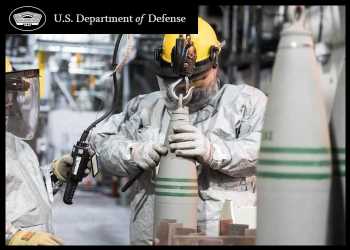
Last Chemical Weapon In U.S. Military Arsenal Destroyed
The United States has destroyed the last chemical weapon in its military arsenal.
The destruction of a large amount of chemical weapon stockpile at Blue Grass Army Depot, Kentucky, ended decades of effort to eliminate chemical weapons, said Douglas Bush, assistant secretary of the army for acquisition, logistics and technology.
The destruction in a safe, secure and environmentally responsible manner was a difficult task, requiring many years to complete, he said at a Pentagon news conference.
In all, more than 30,000 metric tons of declared chemical agent contained in nearly 3.5 million chemical munitions, more than 22,500 one-ton containers containing chemical agent, and more than 50,500 bottles and containers containing chemical agent were destroyed.
Nearly 90 percent of the weapons were eliminated by 2012. The last 10 percent was a greater challenge involving a complicated approach of neutralizing these chemicals. The last mustard gas munition was destroyed last month at the Army’s Pueblo Chemical Depot in Colorado; Blue Grass destroyed the last missile loaded with Sarin nerve agent last week.
“This is an important moment — not only for the United States, but also the entire world,” said Mallory Stewart, assistant secretary of state for the bureau of arms control, verification and compliance. “This achievement is indicative of the important role that international cooperation and transparency play in arms control and disarmament.”
With this, the United Sates has complied with the Chemical Weapons Convention, by destroying its chemical weapon stockpile before the September 30 deadline.
Kingston Reif, deputy assistant secretary of defense for threat reduction and arms control, praised Michael Abaie, the program executive officer of the Army’s Assembled Chemical Weapons Alternatives, for leading a team of thousands of Defense Department civilians and contractors in the $13.5 billion effort.
He added that the mission is not yet complete without ensuring that the facilities used are safe. Officials said that two years of efforts remain before turning out the lights, which is expected to cost another $2.5 billion.
The U.S. Defense officials also worked with other nations to help them destroy their chemical weapons stocks, including Russia, Syria, Albania and Libya.
The Pentagon expresses concern if Russia and Syria have destroyed all their chemical weapons as both nations have a history of using them against their own people.
Source: Read Full Article